Learn all about the Slack branding strategy to grow your SaaS business.
Ever wondered how a workplace tool became so engaging that people actually enjoy using it?
Slack has managed to turn everyday communication into an experience that feels human, approachable, and even cool. From its playful logo to its witty in-app copy and engaging social media, Slack has redefined how B2B brands connect with their audience. But what makes its branding so powerful?
In this blog, we’ll break down Slack’s branding strategy and the key lessons businesses can learn from it.
First, a bit about Slack
Do you know Slack wasn’t meant to be a workplace tool? Yes, it started as an internal chat system for a failed gaming startup, Tiny Speck. When the game flopped, the messaging tool survived, and the rest is history.

Launched in 2013, Slack grew at an insane pace, hitting 8,000 signups on day one and 1.1 million daily active users within two years. Unlike most SaaS companies, Slack barely spent on traditional marketing; word-of-mouth and community-driven growth fueled its rise.
By the time Salesforce acquired it for $27.7 billion in 2021, Slack had become the go-to tool for over 156,000 paying customers.
But can we attribute its success just to its great features? Well, features are one aspect; however, Slack also branded itself differently from the usual workplace software. So, what makes its branding so effective? Let’s break it down.
Slack’s Branding Strategy: Everything You Need to Know
Here’s everything we dug deep into for B2B SaaS lessons – takeaways from Slack’s branding strategy:
1. Strong Visual Identity and Branding Elements
Slack’s visual identity stands out with a distinctive color palette, clean typography, and a modern interface. The simple yet memorable logo reinforces its positioning as an effortless workplace communication tool.
The brand’s color palette reflects its personality, creative, professional, and collaborative. Its bold illustration style makes it instantly recognizable across all communications.
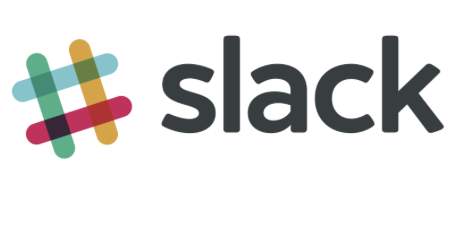
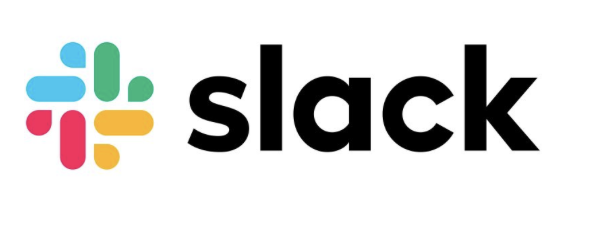
In 2019, Slack refined its branding by simplifying the logo and streamlining its colors, keeping the brand fresh while retaining familiarity. A strong visual identity enhances credibility, fostering trust and customer loyalty.
2. Tone of Voice and Brand Personality
Slack’s tone is friendly, clear, and engaging, making technical communication feel approachable. Product notifications, onboarding messages, and customer support responses use conversational language for a more human-like experience.
Instead of rigid system messages, Slack keeps interactions natural. For instance, an error message might say, “Something went wrong. Let’s fix it together” rather than a generic “Error 404: Request failed.”
Avoiding jargon makes Slack accessible to all users, including those with limited technical knowledge. The onboarding process, for example, uses simple, action-driven prompts like “Let’s set up your first channel” instead of complex instructions.
3. Community Driven Marketing
Slack grew rapidly through organic, community-driven marketing rather than traditional advertising. Word-of-mouth referrals played a significant role in its early adoption, as teams that found Slack useful recommended it to others, creating a viral effect.
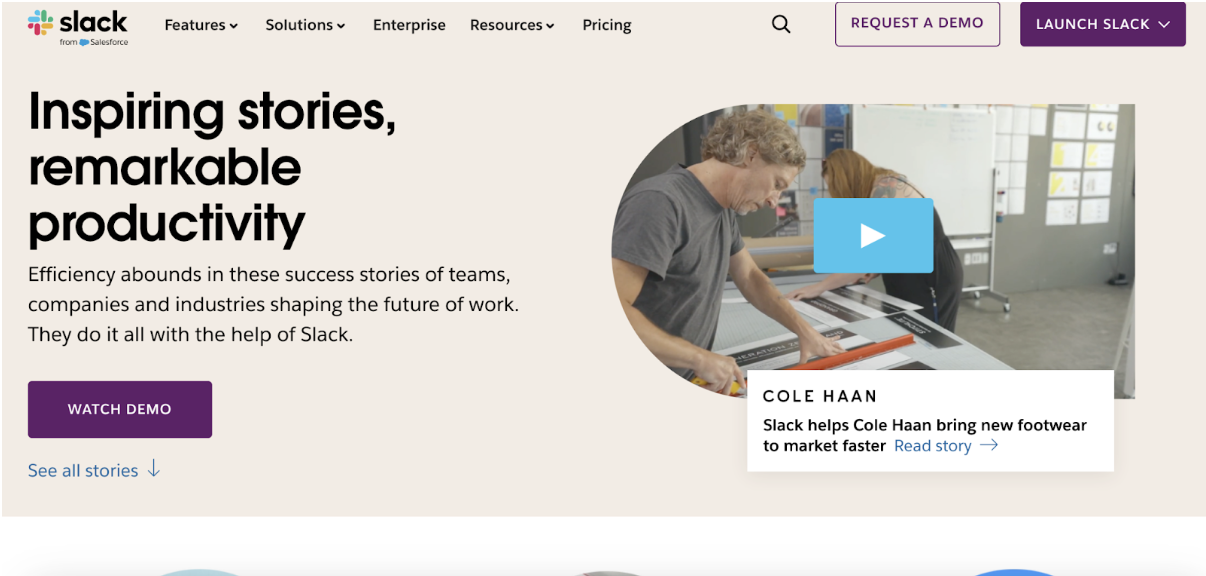
Slack actively engages with its user community, incorporating feedback into product updates and feature requests. This approach makes users feel involved in the platform’s evolution and strengthens loyalty.
User success stories are another key element of Slack’s strategy. Case studies featuring real teams help prospects visualize its value beyond product specifications.
4. Content and Social Media Marketing
Slack’s content marketing prioritizes education and engagement over direct promotion. The company publishes insightful blog posts, webinars, and guides that help businesses improve productivity. Instead of pushing features, Slack demonstrates how teams can work more efficiently.
Slack’s social media approach is platform-specific, ensuring each channel serves a distinct purpose.
Twitter/X: Real time engagement and customer support
Slack actively engages with users through quick responses, troubleshooting, and real-time updates. The brand handles customer support directly on Twitter, often resolving issues within a single thread. Replies maintain a casual yet professional tone, making interactions feel personal. Slack also participates in industry conversations, uses trending hashtags, and runs polls to boost engagement.

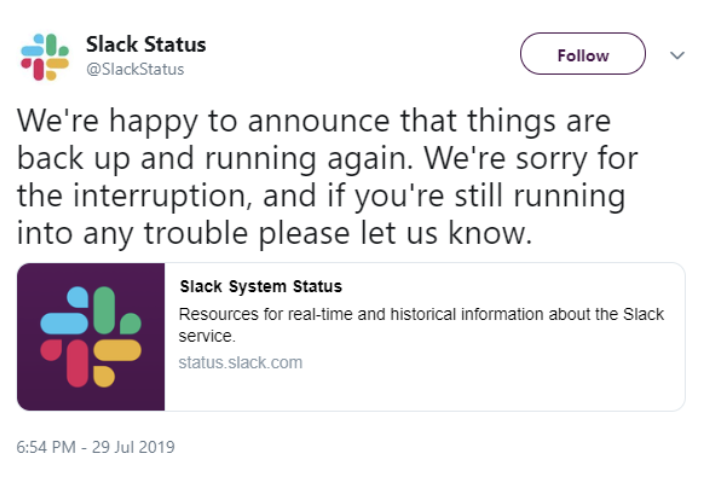
LinkedIn: Thought leadership and case studies
With over 2 million followers, Slack uses LinkedIn to position itself as a workplace productivity leader. The brand shares research-backed insights, industry trends, and real-world use cases featuring well-known brands.

YouTube: Tutorials, Product Demos and Customer Stories
Slack’s YouTube content simplifies product adoption through short tutorials, onboarding guides, and feature breakdowns. Customer success stories highlight real-world transformations, and product update videos demonstrate features in action. A well-organized playlist section and consistent branding contribute to its 64k+ subscribers and millions of views.

Instagram & TikTok: Brand Personality and Workplace Culture
Despite being a B2B brand, Slack has built an engaging presence on Instagram (90k followers) by sticking to its brand colors, using varied content formats, and incorporating user-generated content. Relatable reels, productivity tips, and employee takeovers make the brand approachable while reinforcing its identity as a people-first company.
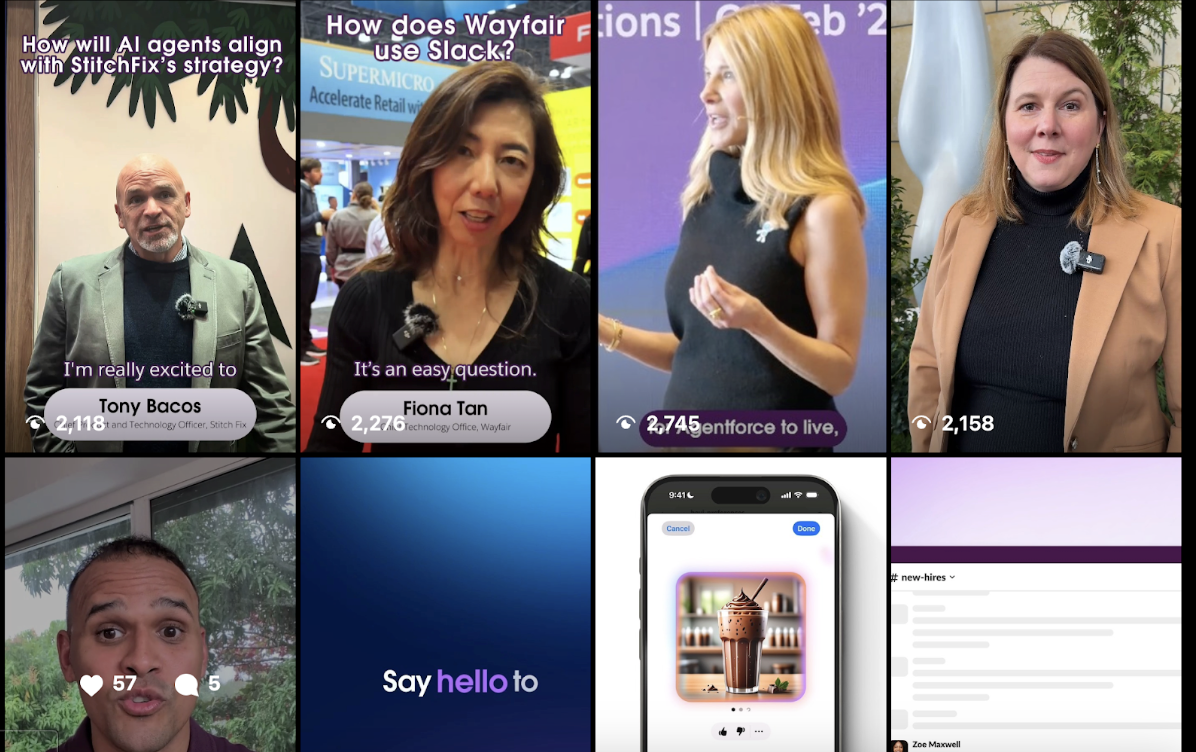
Facebook: Community Engagement and Brand Consistency
Slack maintains a clean, consistent brand presence on Facebook (137k+ followers). It repurposes content from other platforms while engaging users with multimedia posts. The ‘About’ section concisely communicates its value proposition, and direct links drive website traffic.
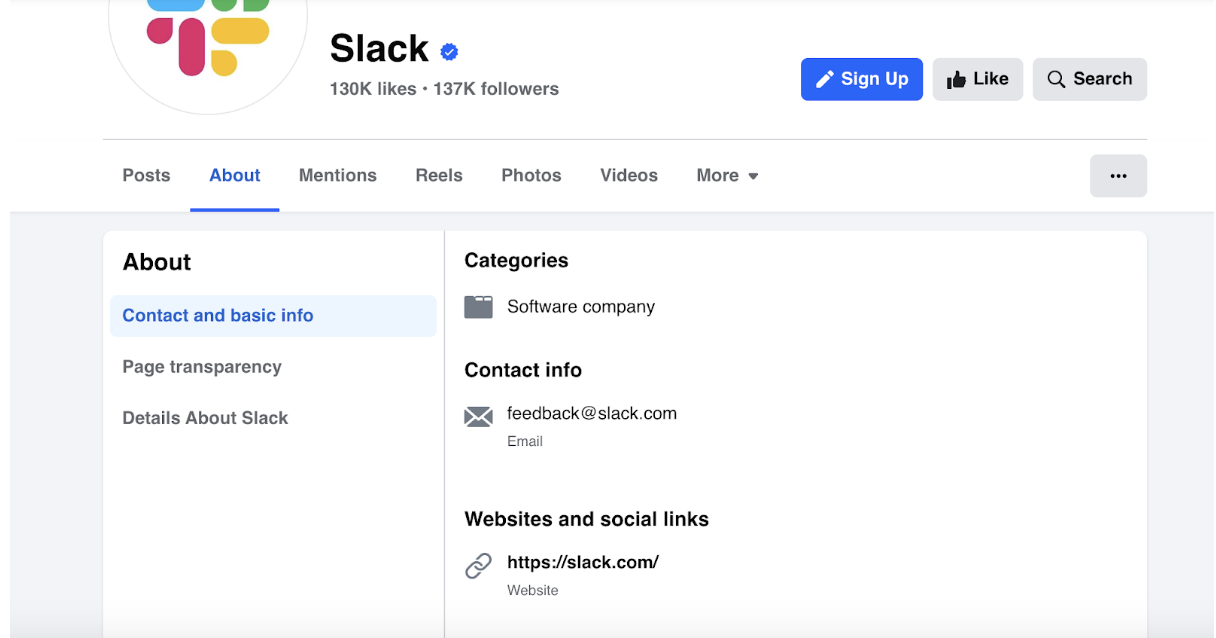
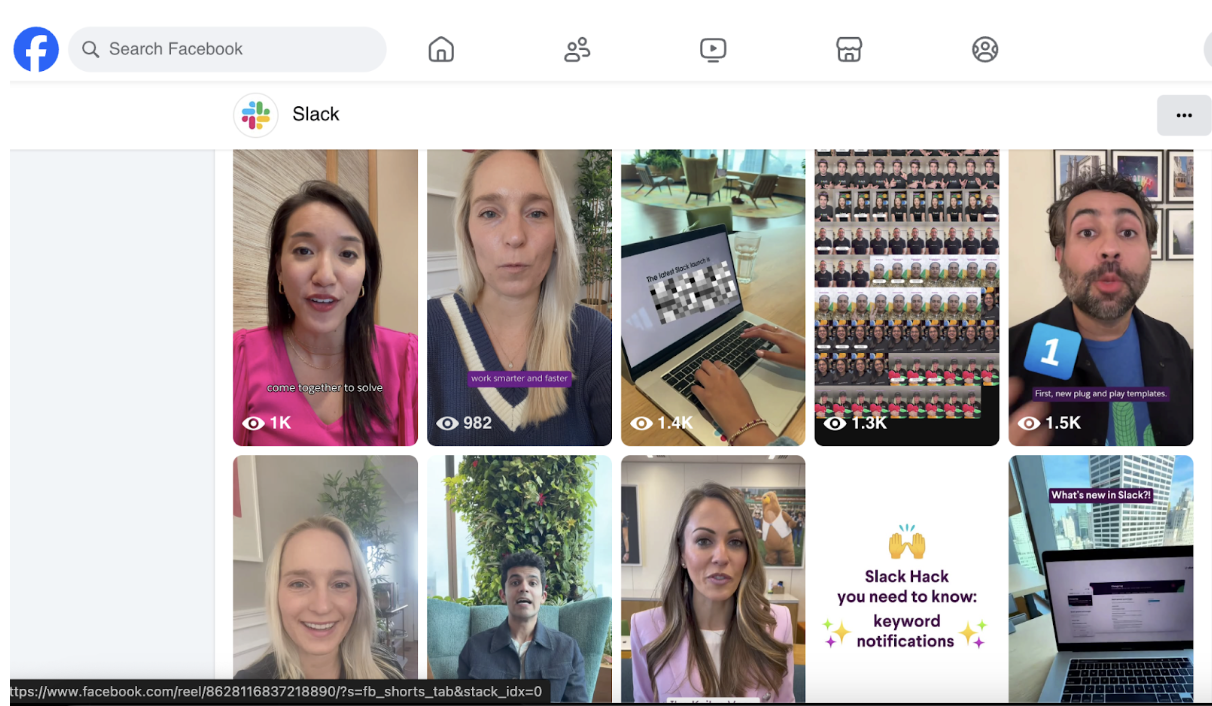
5. Email Marketing
Slack leverages email marketing as a powerful tool to nurture leads, onboard new users, and keep existing customers engaged. Their approach is built on clarity, brevity, and value-driven content, ensuring every email serves a purpose without overwhelming the recipient.
Unlike brands that flood inboxes with lengthy messages, Slack keeps its emails crisp and to the point. A compelling subject line draws attention, followed by short, engaging copy that delivers key insights or updates. Each email includes a clear call-to-action (CTA), guiding users toward the next step, whether it’s exploring a new feature, joining a webinar, or enhancing their Slack experience.
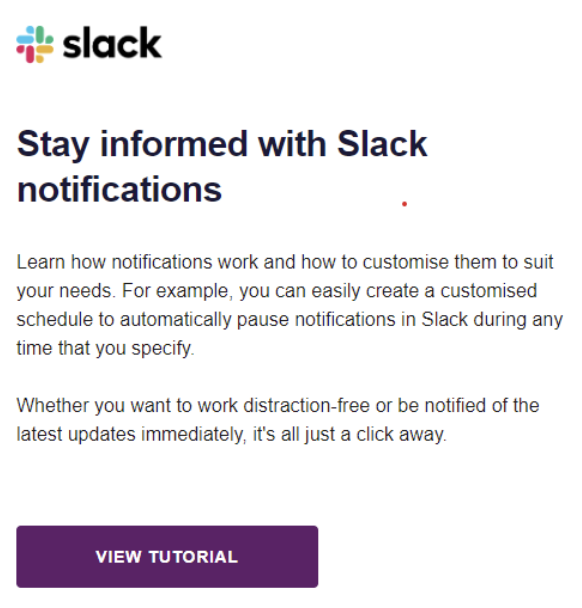
Another reason Slack’s strategy stands out is the cadence of its emails. Rather than bombarding users with frequent promotions, it focuses on sending onboarding sequences, product tips, and essential updates that help users get the most out of the platform. This measured approach prevents email fatigue while reinforcing Slack’s role as an indispensable workplace tool.
6. Customer Experience and Brand Loyalty
Another key aspect of Slack’s social media strategy is an exceptional user experience. The platform is designed for simplicity, allowing teams to onboard quickly without extensive training. Its intuitive interface minimizes friction, making adoption seamless.
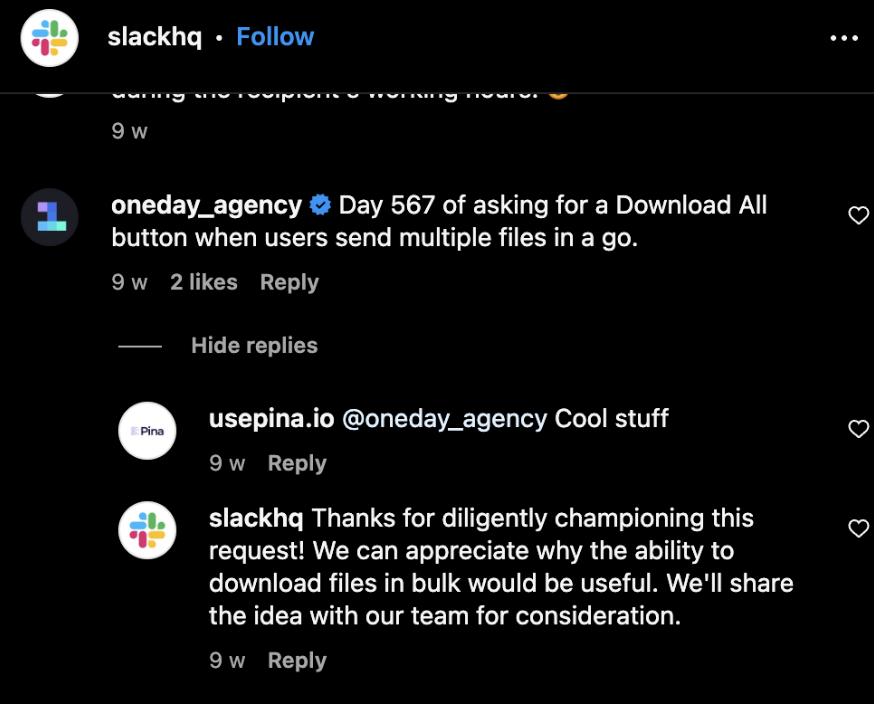

Customer support also plays a crucial role in Slack’s brand loyalty. With fast, efficient assistance across live chat, help centers, and community forums, users get the help they need without delays.
Slack’s freemium model encourages wider adoption by letting users experience core features before committing to a paid plan. This lowers the barrier to entry and builds trust over time.
Gamification further strengthens retention. Features like Slackbot create an interactive onboarding experience, guiding users in an engaging way and making the platform easier to navigate.
7. Partnerships and Integrations
Slack’s growth accelerated through strategic integrations with third-party apps. The platform connects seamlessly with tools like Google Workspace, Zoom, and Trello, embedding itself into workplace workflows and increasing user reliance.
Salesforce’s acquisition of Slack in 2021 further expanded its enterprise positioning, strengthening its appeal among large organizations and solidifying its role in corporate communication.

Slack also encourages developers to build custom integrations through its API, fostering an open ecosystem that drives innovation and enhances user experience.
Cross-promotional partnerships have also played a key role in Slack’s branding success. Collaborative webinars, co-marketing initiatives, and joint reports with other tech companies have amplified its reach and industry influence.
8. Advertising and Campaigns
Slack’s advertising strategy centers on storytelling rather than direct product promotion. Campaigns highlight how Slack transforms teamwork instead of focusing on technical features, creating a stronger emotional connection with users.

One of its most notable campaigns, “So Yeah, We Tried Slack,” showcased companies that initially resisted Slack but later realized its value. Using humor and relatable workplace scenarios, the campaign resonated with potential users and addressed common objections.
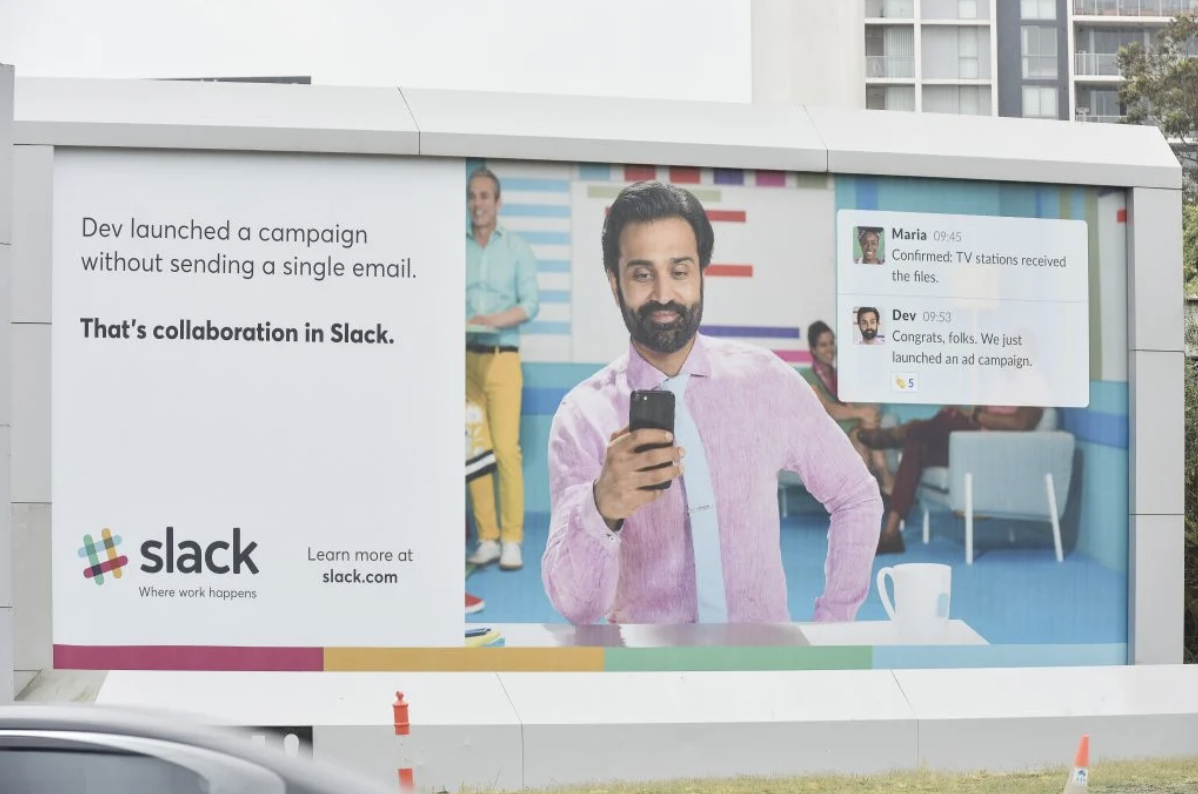
Out-of-home advertising also played a role in Slack’s growth. Billboards in major cities featured concise, witty messages that reinforced the brand’s personality and kept it top-of-mind.
Key Lessons and Takeaways for Your SaaS Business
Here are 10 key lessons for your SaaS businesses from Slack’s branding strategy:
1. Make your brand feel human
Slack’s approachable, friendly tone sets it apart from other workplace tools. You SaaS businesses should focus on conversational language, playful microcopy, and relatable messaging to create an emotional connection with users.
2. Let word of mouth drive growth
Instead of relying on heavy ad spend, Slack prioritized organic growth. Encouraging customer referrals, building an engaged community, and delivering an outstanding product experience can fuel viral adoption.
3. Use a distinct visual identity
A strong, consistent brand identity (logos, colors, typography) helps customers recognize and remember a SaaS product. Slack’s bold yet simple branding makes it instantly identifiable.
4. Leverage community driven marketing
Slack listens to its users, integrates feedback into its product roadmap, and amplifies customer success stories. Your SaaS company can build brand trust by engaging their user community in meaningful ways.
5. Simplify product communication
Slack’s content marketing focuses on education rather than feature-pushing. SaaS brands should use clear, jargon-free messaging to highlight benefits and demonstrate real-world impact.
6. Master the art of email marketing
Slack’s email marketing is concise, value-driven, and never overwhelming. Your SaaS brand should focus on clear CTAs, helpful product tips, and strategic email cadence to enhance user engagement.
7. Enhance customer experience for retention
A seamless onboarding process, intuitive UI, and responsive customer support ensure users stay engaged. Your SaaS brand should prioritize UX and proactive support to drive long-term loyalty.
8. Build an ecosystem with integrations
Slack’s success is partly due to its vast integrations. SaaS businesses can boost product stickiness by integrating with popular tools their customers already use.
9. Run creative and relatable campaigns
Instead of feature-heavy ads, Slack’s marketing tells stories about how it transforms workplaces. Hence, your SaaS business can focus on storytelling and emotional appeal in their campaigns.
10. Balance free and paid value
Slack’s freemium model lets users experience the product before upgrading. Similarly you can attract users with a strong free tier while offering premium features that encourage conversion.
Closing thoughts
Slack’s branding success is a masterclass in how SaaS companies can create a distinct and memorable identity. From its vibrant visuals to its friendly, human-centric messaging, Slack proves that branding isn’t just about logos, it’s about crafting an experience that resonates with users.
If your SaaS brand is struggling to stand out and connect with the right audience, we at Brand Strategy Lab can help. From A to Z and everything in between, we specialize in building brands that not only look great but also drive real business impact.




